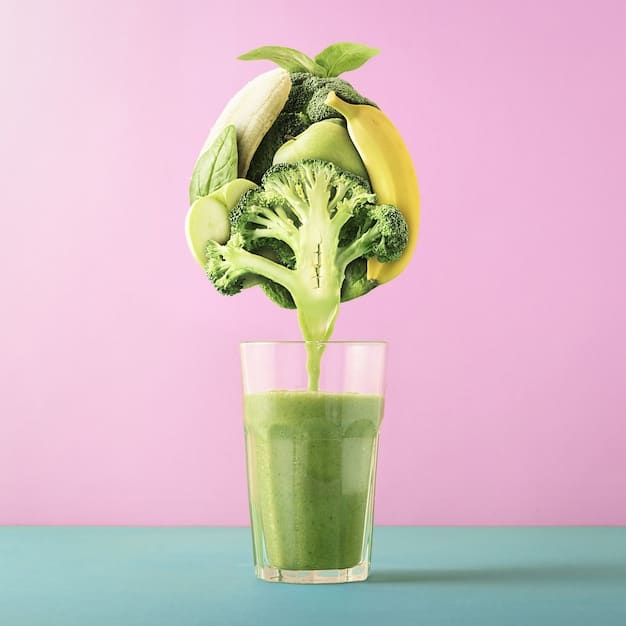7 Steps to Naturally Lower Blood Pressure in 3 Months

Lowering blood pressure naturally within three months involves a holistic approach, integrating dietary changes, consistent physical activity, stress management techniques, and lifestyle adjustments, often providing a sustainable alternative or complement to medication.
Embarking on a journey to health often starts with actionable steps. When it comes to managing hypertension, finding practical solutions: 7 steps to lower your blood pressure naturally in 3 months can feel like a monumental task. But it doesn’t have to be. This guide will walk you through a clear, achievable path to better cardiovascular health.
Understanding High Blood Pressure: The Silent Threat
High blood pressure, or hypertension, is often dubbed the “silent killer” because it typically presents no symptoms, yet significantly increases the risk of heart disease, stroke, kidney failure, and other serious health problems. It’s a condition where the force of blood against your artery walls is consistently too high, putting undue strain on your entire cardiovascular system. Understanding the basics is the first crucial step toward effective management and prevention.
Many factors contribute to high blood pressure, ranging from genetics to lifestyle choices. While you can’t change your genetic predisposition, you can certainly influence the lifestyle components. These include dietary habits, physical activity levels, stress management, and even sleep quality. Recognizing these influences empowers you to take proactive steps rather than feeling helpless against a perceived inevitable condition. Regular monitoring is key; knowing your numbers provides a baseline and helps track progress. For most adults, a healthy blood pressure reading is below 120/80 mm Hg. Consistently elevated readings, particularly above 130/80 mm Hg, warrant medical attention and a discussion about potential interventions.
The long-term impact of uncontrolled hypertension
Leaving high blood pressure untreated can lead to a cascade of health issues. The persistent pressure on your arteries can damage their inner lining, making them stiffer and less elastic over time. This process, known as atherosclerosis, narrows the arteries, further elevating blood pressure and increasing the risk of blood clots.
- Heart Health: Uncontrolled hypertension can lead to heart attack, heart failure, and coronary artery disease. Your heart has to work harder to pump blood against increased resistance, leading to thickening of the heart muscle and eventually, weakening.
- Stroke: High blood pressure is a leading cause of stroke. Weakened blood vessels in the brain can burst, or clots can block blood flow, depriving brain tissue of oxygen and nutrients.
- Kidney Disease: The delicate blood vessels in your kidneys can be damaged by high blood pressure, impairing their ability to filter waste from your blood. This can lead to chronic kidney disease or even kidney failure.
- Vision Loss: Retinopathy, damage to the blood vessels in the eyes, can occur, potentially leading to vision impairment or blindness.
It’s clear that understanding and addressing hypertension is not merely about a number on a gauge; it’s about safeguarding your overall health and quality of life for years to come. The good news is that many natural strategies can effectively lower blood pressure, often without the need for medication, or by reducing the reliance on it.
Step 1: Embrace Dietary Changes with the DASH Diet
When it comes to lowering blood pressure naturally, diet plays an unparalleled role. The Dietary Approaches to Stop Hypertension (DASH) diet is not just a diet; it’s a comprehensive eating plan proven to significantly reduce blood pressure within weeks. It emphasizes foods rich in potassium, calcium, and magnesium, which are essential minerals for blood pressure regulation, while limiting sodium, saturated fats, and cholesterol.
The DASH eating plan is flexible and designed to be sustainable long-term. It encourages a significant increase in fruits, vegetables, and whole grains, and includes lean protein sources and healthy fats. The focus is on nutrient-dense foods that naturally support cardiovascular health.
Key components of the DASH diet
Adopting the DASH diet involves making specific food choices. It’s about building meals around nutrient-rich foods and being mindful of portion sizes. The emphasis is on a broad spectrum of healthy foods rather than strict restrictions.
- Increase Fruit and Vegetable Intake: Aim for 4-5 servings of vegetables and fruits daily. These are packed with potassium, magnesium, and fiber, all crucial for blood pressure management.
- Choose Whole Grains: Opt for whole-grain bread, pasta, and cereals over refined versions. Whole grains provide fiber and nutrients that contribute to heart health.
- Lean Protein Sources: Include fish, poultry, beans, and nuts in your diet. These offer protein without excessive saturated fat.
Limiting sodium intake is another cornerstone of blood pressure management. Processed foods, restaurant meals, and many packaged goods are often high in hidden sodium. Becoming a label reader and choosing fresh, unprocessed foods are effective ways to cut down on sodium. Over time, your taste buds adapt, and you’ll find naturally flavorful foods more satisfying.
Maintaining a balanced intake of healthy fats from sources like avocados, nuts, and olive oil can also contribute to overall cardiovascular health. These fats are essential for various bodily functions and can help reduce bad cholesterol levels, which indirectly supports healthy blood pressure.
Step 2: Incorporate Regular Physical Activity
Physical activity is a powerful tool in your arsenal against high blood pressure. Regular exercise strengthens your heart, allowing it to pump blood more efficiently with less effort. This reduces the force on your arteries, leading to lower blood pressure. Even moderate activity can make a significant difference.
The key is consistency. Aim for at least 150 minutes of moderate-intensity aerobic exercise per week, or about 30 minutes on most days. This could include brisk walking, jogging, cycling, swimming, or dancing. Any activity that elevates your heart rate and makes you slightly breathless counts.
Making exercise a daily habit
Starting an exercise routine doesn’t require a gym membership or specialized equipment. Many effective activities can be done at home or outdoors. The most important thing is to find activities you enjoy, making it easier to stick with them.
- Brisk Walking: A simple yet effective form of exercise. Start with 15-20 minutes daily and gradually increase duration and intensity.
- Strength Training: Incorporate strength exercises 2-3 times a week. This builds muscle, which helps burn more calories and contributes to overall fitness.
- Mind-Body Exercises: Activities like yoga or Tai Chi combine physical movement with mindfulness, which can also help manage stress, a factor in blood pressure.
Consulting with a healthcare professional before starting any new exercise regimen is always advisable, especially if you have pre-existing health conditions. They can help you tailor an exercise plan that is safe and effective for your individual needs. Remember, even short bursts of activity throughout the day add up and contribute to overall health. Take the stairs instead of the elevator, park further away, or take short walks during breaks.

Step 3: Manage Stress Effectively
Stress is an undeniable part of modern life, and while acute stress can cause temporary spikes in blood pressure, chronic stress can contribute to sustained hypertension. When you’re stressed, your body releases hormones that constrict blood vessels and accelerate heart rate, leading to increased blood pressure. Learning to manage stress is therefore a vital component of any natural blood pressure reduction plan.
Effective stress management isn’t about eliminating stress entirely—an impossible task—but rather about developing healthy coping mechanisms. It involves identifying your stressors and finding constructive ways to respond to them, preventing their negative physiological effects. This could range from simple daily practices to more structured therapeutic approaches.
Techniques for stress reduction
There’s no one-size-fits-all approach to stress management. Experiment with different techniques to discover what works best for you. Consistency is key, as regular practice helps build resilience against stress.
- Mindfulness and Meditation: Practices that focus on the present moment can calm the nervous system and reduce stress hormones. Even a few minutes daily can yield benefits.
- Deep Breathing Exercises: Simple yet powerful, deep diaphragmatic breathing can immediately lower heart rate and blood pressure.
- Hobbies and Relaxation: Engage in activities you enjoy, whether it’s reading, listening to music, gardening, or spending time in nature. These provide a much-needed break from daily pressures.
Consider setting aside dedicated time each day for relaxation. This could be a quiet moment for reflection, a short walk, or indulging in a creative pursuit. Additionally, maintaining strong social connections and seeking support from friends, family, or a professional counselor can significantly buffer the impact of stress on your health. Prioritizing self-care and recognizing symptoms of chronic stress are crucial steps in managing your blood pressure naturally.
Step 4: Reduce Sodium Intake and Increase Potassium
Sodium and potassium have a direct and significant impact on blood pressure. Most modern diets are high in sodium and relatively low in potassium, creating an imbalance that contributes to hypertension. Adopting a dietary strategy that reverses this trend is a cornerstone of natural blood pressure management.
Reducing sodium isn’t just about putting away the salt shaker. About 70% of the sodium we consume comes from processed and restaurant foods. This means a concerted effort to read food labels, choose low-sodium options, and prepare more meals at home from scratch is necessary. Conversely, increasing potassium intake counteracts the negative effects of sodium and helps relax blood vessel walls.
Strategies for sodium control and potassium boost
Making these changes systematically over three months can lead to substantial improvements in blood pressure readings. It helps your body achieve a more balanced state regarding fluid regulation and arterial health.
- Read Food Labels: Pay close attention to the sodium content in packaged foods. Look for “low sodium” or “no added salt” options.
- Cook at Home: Preparing meals allows you to control the amount of sodium used. Experiment with herbs and spices for flavor instead of salt.
- Embrace Potassium-Rich Foods: Incorporate more fruits (bananas, oranges), vegetables (spinach, sweet potatoes), and legumes into your diet.
Be cautious of hidden sodium in unexpected places, such as bread, cereals, and salad dressings. Opting for fresh, unprocessed ingredients whenever possible is the simplest way to manage sodium intake. For potassium, consider a diverse intake of fruits and vegetables rather than relying on supplements, as dietary sources provide a broader spectrum of essential nutrients. A balanced approach to both sodium and potassium is far more effective than focusing on just one.
Step 5: Maintain a Healthy Weight
Excess weight, particularly around the waistline, significantly increases the risk of high blood pressure. When you carry extra pounds, your heart has to work harder to pump blood throughout your body. This increased workload puts additional strain on your arteries, leading to elevated blood pressure over time. Losing even a modest amount of weight can have a profound positive impact on your blood pressure.
Weight loss is not about drastic diets but about making sustainable lifestyle changes that lead to a healthy calorie deficit. Combining dietary adjustments with regular physical activity is the most effective and sustainable approach to achieving and maintaining a healthy weight. This synergistic effect not only helps shed pounds but also directly improves cardiovascular health.
Practical steps for weight management
Setting realistic weight loss goals and focusing on gradual, consistent progress is more effective than attempting rapid, unsustainable changes. Aim for a healthy weight loss of 1-2 pounds per week.
- Portion Control: Be mindful of how much you eat. Use smaller plates, measure out servings, and pay attention to your body’s hunger and fullness cues.
- Balanced Diet: Emphasize whole, unprocessed foods, as outlined in the DASH diet. These foods are generally lower in calories and higher in nutrients, promoting satiety.
- Increased Activity: Integrate more movement into your daily routine. Burning more calories through exercise complements dietary changes by increasing energy expenditure.
Remember that weight loss is a journey, and setbacks can happen. Focus on long-term habits rather than short-term fixes. Celebrating small victories along the way can help maintain motivation. Seeking support from a dietitian or a healthcare professional can provide personalized guidance and strategies tailored to your specific needs and health profile. Sustainable weight management is a crucial factor in naturally lowering and maintaining healthy blood pressure levels.

Step 6: Limit Alcohol and Quit Smoking
Two significant lifestyle factors heavily influence blood pressure: alcohol consumption and smoking. Both can directly elevate blood pressure and contribute to long-term cardiovascular damage. Addressing these habits is a critical step in a natural approach to blood pressure reduction.
Excessive alcohol intake can raise blood pressure, and it can also interfere with the effectiveness of certain blood pressure medications. Smoking, on the other hand, immediately raises blood pressure and heart rate, while the chemicals in tobacco smoke damage the lining of blood vessels, leading to hardening of the arteries. Eliminating or significantly reducing these habits is paramount.
Strategies for reducing harmful habits
Making these changes can be challenging, but the health benefits are immense and often immediate. Support systems and professional guidance can be invaluable in this process.
- Moderate Alcohol Intake: If you drink alcohol, do so in moderation. This means up to one drink per day for women and up to two drinks per day for men. More than this can significantly impact blood pressure.
- Seek Support to Quit Smoking: Quitting smoking is one of the best things you can do for your overall health. Utilize resources like nicotine replacement therapy, support groups, or counseling.
- Identify Triggers: Understanding what prompts you to drink or smoke can help you develop coping strategies and avoid high-risk situations.
Even a slight reduction in alcohol intake can positively affect blood pressure. For smoking, cessation is the ultimate goal, as even sporadic smoking causes damage. The benefits of quitting smoking are almost immediate, with blood pressure and heart rate beginning to normalize within hours of your last cigarette. Over time, your risk of cardiovascular disease drops significantly. These changes not only lower blood pressure but also dramatically improve your overall health and longevity.
Step 7: Prioritize Quality Sleep
The importance of sleep often gets overlooked in health discussions, but it plays a crucial role in regulating blood pressure. During sleep, your blood pressure naturally dips, giving your heart and blood vessels a much-needed rest. Prolonged sleep deprivation or poor sleep quality can disrupt this natural rhythm, leading to consistently higher blood pressure readings.
Chronic lack of sleep triggers the body’s stress response, releasing hormones that keep blood pressure elevated. It can also affect other health factors, such as appetite regulation and glucose metabolism, indirectly contributing to conditions that impact blood pressure. Aiming for 7-9 hours of quality sleep per night is not just about feeling rested; it’s a vital component of cardiovascular health.
Establishing healthy sleep habits
Creating a conducive environment and routine for sleep can significantly improve both the quantity and quality of your rest. Consistency is key when it comes to sleep hygiene.
- Maintain a Consistent Sleep Schedule: Go to bed and wake up at the same time each day, even on weekends. This helps regulate your body’s natural sleep-wake cycle.
- Create a Relaxing Bedtime Routine: Wind down with activities like reading, taking a warm bath, or listening to calming music. Avoid screens before bed.
- Optimize Your Sleep Environment: Ensure your bedroom is dark, quiet, and cool. Invest in a comfortable mattress and pillows.
Avoid caffeine and heavy meals close to bedtime, and limit afternoon naps if they interfere with nighttime sleep. If you consistently struggle with sleep despite implementing these strategies, consider consulting a healthcare professional. Conditions like sleep apnea, a common cause of disrupted sleep and a risk factor for hypertension, may require medical intervention. Prioritizing quality sleep is a gentle yet powerful step towards naturally lowering and maintaining healthy blood pressure levels.
| Key Step | Brief Description |
|---|---|
| 🍎 Dietary Changes | Adopt the DASH diet, focusing on whole foods, low sodium, and high potassium. |
| 🏃♀️ Regular Exercise | Engage in at least 150 minutes of moderate-intensity aerobic activity weekly. |
| 🧘♀️ Stress Management | Practice mindfulness, deep breathing, and engage in relaxing hobbies daily. |
| ⚖️ Healthy Weight | Achieve and maintain a healthy BMI through balanced diet and consistent activity. |
Frequently Asked Questions
While individual results vary, many people begin to see noticeable improvements in their blood pressure readings within a few weeks of consistently applying these natural strategies. Significant reductions can often be achieved within the three-month timeframe, as the body adapts to healthier habits.
It is crucial to consult your doctor before making any changes to your medication regimen. These natural strategies are intended to complement medical treatment. Your doctor may adjust your medication dosage or even discontinue it if your blood pressure responds well to lifestyle changes, but this decision must always be made under medical supervision.
According to the American Heart Association, a normal blood pressure reading is less than 120/80 mm Hg. Readings consistently above this, especially 130/80 mm Hg or higher, are considered elevated or high blood pressure and warrant a conversation with your healthcare provider about management strategies.
While some supplements like magnesium, potassium, or omega-3 fatty acids may play a role in blood pressure regulation, they should never replace comprehensive lifestyle changes or prescribed medication. Always consult your doctor before taking any supplements, as they can interact with medications or have adverse effects.
Consistency is paramount. Blood pressure improvement through natural means is a cumulative effect of sustained healthy habits. Sporadic efforts yield minimal results. Adhering to the dietary changes, exercise routine, stress management, and other steps daily is what drives lasting positive outcomes within the three-month window and beyond.
Conclusion
Embarking on the journey to lower blood pressure naturally is a commitment to your long-term health and well-being. By diligently implementing these practical solutions: 7 steps to lower your blood pressure naturally in 3 months, you are taking proactive control over a significant aspect of your cardiovascular health. Remember, consistency is key, and every small, positive change contributes to the larger goal. While these steps are highly effective, always maintain open communication with your healthcare provider to ensure your approach is safe, effective, and tailored to your individual needs. Your three-month commitment can truly transform your health.





